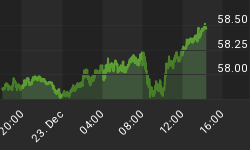I am following two potential EW counts:
1. Double Zig Zag:
In this monthly chart I have labelled the pattern from the July 2008 top as a potential Double Zig Zag. If this EW count is correct on July 2012 price has established the second wave (A), hence the following advance will establish the top of the second wave (B). Once the wave (B) is in place it will be followed by the last wave (Y) down that could have the similar size as the preceding wave (A) = - 0.29 €.
So far this count looks ok since the structure of the pattern from the July 2012 is clearly corrective.
We can make the case that price will unfold a 3-wave up leg. (either a ZZ or a DZZ)
The equality extension target is located at 1.4424.
On the way to this theoretical target price will have to overcome:
-
The immediate resistance located at the February peak = 1.3711.
-
The 0.618 retracement of the down leg off the May 2011 high and horizontal support located at 1.3833.
-
Trend line resistance that connects the July 2008 high with the May 2011 lower high. This trend line at the end of October will stand at 1.4000 +/-. (It drops 0.0034 € +/- each month)
On the face of it seems probable that price will reach at least the mentioned trend line.
2. Triangle:
We can use the same price levels discussed above.
Instead of the second wave (B) price is now unfolding the wave (E) of the Triangle.
The assumed wave (E) could establish its top either at the mentioned trend line (Blue one) or it could reach the 1 x 1 extension target and the black trend line that connects the November 2009 peak with the May 2011 lower high, therefore the target will be located +/- in the range 1.4424 - 1.4600
Once the wave (B) is in place it will be followed by a "thrust" wave (C) down which has a measured length of - 0.3185 €. (The Eur would lose the parity)
Lets move on to the shorter time frame using a weekly chart.
From the July 2012 low, in my opinion, price is unfolding a Double Zig Zag. If this count is correct we are now in the late stages or the top of the second wave (A). I am using the word top because we can see that in the preceding three weekly candlesticks price has been rejected at the upper Bollinger Band in addition the current one is a doji and the preceding two weekly candlesticks are a Shooting Star and a doji. These candlesticks are suggesting indecision and a loss of upside momentum.
If the wave (A) is in place then I expect that the following wave (B) pullback should find a bottom in the range 1.3290 (Weekly gap fill) - 1.3254 (20 wma).
If we look at the weekly momentum, the picture is bullish but the Stochastic is overbought:
-
Weekly RSI is displaying a strong momentum off the July lows.
-
MACD has a bullish cross in force since the July lows.
Next lets analyse the pattern from the July 9 low:
As usual the pattern is once again corrective with another Double Zig Zag.
As I suggested last Thursday on Stocktwits/Twitter, price has kicked off a thrust following a Triangle. If this is the case the Double Zig Zag, barring an extension higher with an impulsive sequence could be complete.
The weekly spinning top above the upper Bollinger Band is suggesting that this move should have run its course.
If a top is in place (Second wave A of the DZZ discussed in the weekly time frame), even though there are plenty of supports to be breached, the minimum retracement level (0.382 Retracement) is located at 1.3340, while below it we have the weekly gap and the 100 dma in the range 1.3290 - 1.3284.
Daily momentum is displaying a triple negative divergence of the RSI (5) and a negative divergence of the RSI (14) suggesting that price has lost upside momentum.
However since the stochastic is not overbought we have to watch the MACD, which has a potential "Bullish Failure" set up if next week it confirms a sell signal cross.
Bullish sentiment is also aligned with the scenario of an imminent pullback. (Contrarian indicator)

But this is not a free-market since exogenous factors such as the FED (It obviously wants a weak USD) and the market expectation of a delay of "tapering" may curb the expected pullback.






















